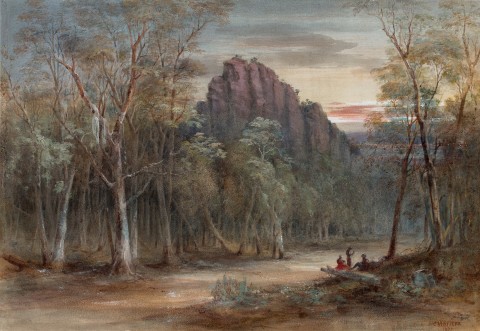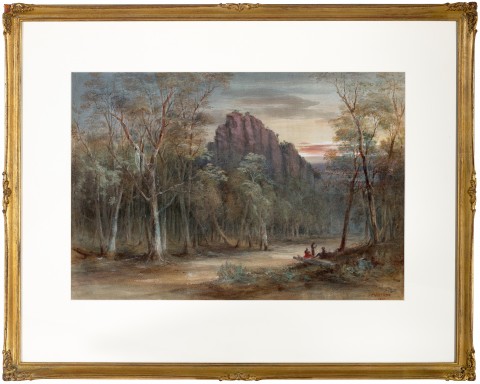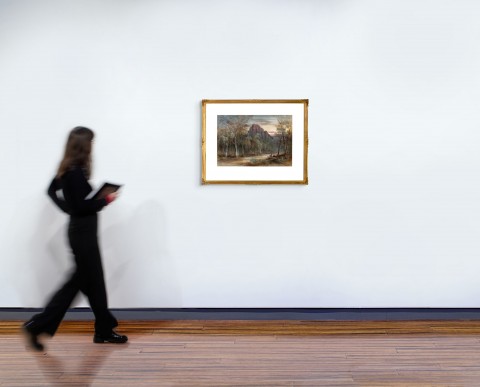ROAD SCENE APPROACH TO CROWN RIDGE, 1877
CONRAD MARTENS
watercolour and gouache on paper
43.5 x 63.0 cm
signed and dated lower right: C. Martens / 1877
Josiah Austin, Melbourne, acquired directly from the artist in 1877
James R. Lawson, Sydney, 30 September 1941, lot 289 (as ’The Road through the Capertee Valley’)
Mr Croker, Sydney, acquired from the above
Thence by descent
Alan M. Croker, Sydney
Geoff K. Gray, Sydney, 8 October 1985, lot 100 (as ‘Blackmans crossing above the Caper Tree [sic] Valley on the Mudgee Rd’, illus. on catalogue cover)
Private collection, Sydney, acquired from the above
Thence by descent
Private collection, Sydney
Conrad Martens Account Book, 1856 – 1878, Mitchell Library, State Library of New South Wales, Sydney (as ‘Road scene approach to Crown Ridge, (or Blackman’s Crown), on Mudgee Road.’ Josiah Austin Esq. of Melbourne, £25.0.0.)
de Vries–Evans, S., Conrad Martens on the Beagle and in Australia, Pandanus Press, Brisbane, 1993, p. 196
Near the Crown Ridge, 1874, pencil on paper, 28.9 x 45.7 cm, in Conrad Martens Sketchbook, Volume 02: Conrad Martens sketches from the Blue Mountains, Lithgow and Capertee, 1873 - 76, State Library of New South Wales, Sydney, accession number: ZPXD 307, f.3
Study for Crown Ridge, looking east, 1874/75, watercolour, 35.0 x 53.0 cm, private collection
Crown Ridge, looking east, 1875, watercolour and pencil with bodycolour and gum arabic, 42.0 x 64.5 cm (sight), State Library of New South Wales, Sydney
Crown Ridge, Blue Mountains, New South Wales, watercolour, 43.0 x 64.5 cm, private collection
The most significant landscape artist working in Sydney in the mid-nineteenth century, Conrad Martens first witnessed the towering sandstone escarpments and seemingly endless valleys of the Blue Mountains shortly after his arrival in 1835. He had intended to visit Australia only briefly but soon recognised the rich opportunities for artistic inspiration and a potential market in the burgeoning colony of New South Wales. Similarly impressive natural landscapes seen on his extensive travels throughout eastern New South Wales and southern Queensland were to form an important part of his oeuvre throughout his long career.
In December 1874, Martens, then in his seventies, travelled to the Blue Mountains and the Central Tablelands beyond. His decisions to take this route may have been inspired by a glowing account of the Capertee Valley, on Wiradjuri Country, published a few months earlier: ‘I enjoyed the fresh bracing air at the Crown [Ridge Hotel], and the next morning was up at sunrise. A little over a mile from the hotel the road winds round the Crown Ridge, and as I ascended there opened to view a truly marvellous picture. To those who love the glories of light and shade, of boundless extent, magnificence of scenery, beauty and sublimity, I would recommend a view at sunrise or sunset over the valley of Capertee. Along the lowest range or tiers of hills, a thousand feet below there is a sombre shade; higher up a lighter tinge almost approaching green; and then above the great peaks the natural towers of rocks and battlement stretching miles away are gloriously bathed in golden sheen.’1
As always, Martens sketched along his route including several swift pencil drawings around Crown Ridge (now named Blackmans Crown, after explorer James Blackman) – including the aforementioned hotel, where both Martens and the anonymous writer stayed, and a sketch for this painting.2 Upon his return to Sydney, these sketches informed his accomplished presentation of watercolours of this dramatic landscape. Crown Ridge looking east (State Library of New South Wales) and Crown Ridge, Blue Mountains (private collection) both show the vertiginous nature of the roads as they wind along escarpments, with gums clinging precariously to the rocks. In contrast, the present watercolour looks not down but rather up, from the densely forested valley floor to the looming formation on the near horizon. The pencil sketch shows Martens’ great attention to detail in the tree branches, vegetation and geological layers. With the addition of colour, the pyramidic form is outlined against the liminal sky. This watercolour was purchased by Josiah Austin, a Western District pastoralist not otherwise known as a patron of Martens or collector of art.
1. Anonymous, ’A Tour to the North-Western Interior: Wallerawang to Mudgee’, Australian Town and Country Journal, 27 June 1874, p. 28, see: http://nla.gov.au/nla.news-article70475573 (accessed February 2025)
2. Near the Crown Ridge, 1874, pencil on paper, in Martens, C., Volume 02: Conrad Martens sketches from the Blue Mountains, Lithgow and Capertee, 1873 – 76, State Library of New South Wales, Sydney, ZPXD 307, f.3, together with f. 2 Crown Ridge and f. 4 Crown Ridge Inn.
ALISA BUNBURY


